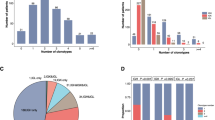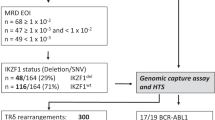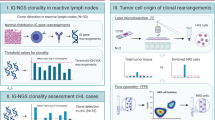Abstract
Detection of minimal residual disease (MRD), using immunoglobulin (Ig) and T-cell receptor (TCR) gene rearrangements as clone-specific targets, represents the most recent development in diagnosis and treatment of acute lymphoblastic leukaemia (ALL). Nevertheless, risk of false-negative results, due to secondary or ongoing rearrangements of Ig/TCR genes during the disease course, might hamper MRD detection. Therefore, to gain extensive information on clonal stability, we performed PCR-GeneScan analysis of Ig/TCR gene rearrangements at diagnosis and subsequent relapse in bone marrow samples from 53 childhood precursor-B-ALL patients. In addition, sequencing analysis of junctional regions at diagnosis and relapse provided a detailed insight in the stability and changes of Ig/TCR gene rearrangements during the disease course. At least one stable clonal Ig/TCR target was found in 94% of patients. In three patients complete differences in Ig/TCR rearrangements between diagnosis and relapse were observed, suggesting relapse with a new clone. At relapse, 71% of diagnostic clonal PCR targets was conserved. Since the comparison of Ig/TCR gene rearrangements at diagnosis and relapse in our precursor-B-ALL patients did not show significant difference in the stability of different clonal PCR targets (IGH, 70%; IGK, 71%; TCRD, 67%; TCRG, 75%), we conclude that there is no ‘preferential’ clone-specific target for MRD monitoring.
This is a preview of subscription content, access via your institution
Access options
Subscribe to this journal
Receive 12 print issues and online access
$259.00 per year
only $21.58 per issue
Buy this article
- Purchase on Springer Link
- Instant access to full article PDF
Prices may be subject to local taxes which are calculated during checkout




Similar content being viewed by others
References
Pui CH, Relling MV, Campana D, Evans WE . Childhood acute lymphoblastic leukemia. Rev Clin Exp Hematol 2002; 6: 161–180.
Conter V, Arico M, Valsecchi MG, Basso G, Biondi A, Madon E et al. Long-term results of the Italian Association of Pediatric Hematology and Oncology (AIEOP) acute lymphoblastic leukemia studies, 1982–1995. Leukemia 2000; 14: 2196–2204.
van Dongen JJ, Seriu T, Panzer-Grumayer ER, Biondi A, Pongers-Willemse MJ, Corral L et al. Prognostic value of minimal residual disease in acute lymphoblastic leukaemia in childhood. Lancet 1998; 352: 1731–1738.
Cave H, van der Werff ten Bosch J, Suciu S, Guidal C, Waterkeyn C, Otten J et al. Clinical significance of minimal residual disease in childhood acute lymphoblastic leukemia. European Organization for Research and Treatment of Cancer, Childhood Leukemia Cooperative Group. N Engl J Med 1998; 339: 591–598.
Pui CH, Campana D . New definition of remission in childhood acute lymphoblastic leukemia. Leukemia 2000; 14: 783–785.
Arico' M, Germano G, del Giudice L, Ziino O, Locatelli F, Basso G . Late relapse of childhood acute lymphoblastic leukemia and PCR-monitoring of minimal residual disease: how much time can elapse between ‘molecular’ and clinical relapse? Haematologica 2002; 87: ELT19. Available from http://www.haematologica.it/e-letters/2002_04/19.htm
Pongers-Willemse MJ, Verhagen OJ, Tibbe GJ, Wijkhuijs AJ, de Haas V, Roovers E et al. Real-time quantitative PCR for the detection of minimal residual disease in acute lymphoblastic leukemia using junctional region specific TaqMan probes. Leukemia 1998; 12: 2006–2014.
Verhagen OJ, Willemse MJ, Breunis WB, Wijkhuijs AJ, Jacobs DC, Joosten SA et al. Application of germline IGH probes in real-time quantitative PCR for the detection of minimal residual disease in acute lymphoblastic leukemia. Leukemia 2000; 14: 1426–1435.
Pongers-Willemse MJ, Seriu T, Stolz F, d'Aniello E, Gameiro P, Pisa P et al. Primers and protocols for standardized detection of minimal residual disease in acute lymphoblastic leukemia using immunoglobulin and T cell receptor gene rearrangements and TAL1 deletions as PCR targets: report of the BIOMED-1 CONCERTED ACTION: investigation of minimal residual disease in acute leukemia. Leukemia 1999; 13: 110–118.
Davis MM, Bjorkman PJ . T-cell antigen receptor genes and T-cell recognition. Nature 1988; 334: 395–402.
van Dongen JJ, Szczepanski T, de Bruijn MA, van den Beemd MW, de Bruin-Versteeg S, Wijkhuijs JM et al. Detection of minimal residual disease in acute leukemia patients. Cytokines Mol Ther 1996; 2: 121–133.
Szczepanski T, Beishuizen A, Pongers-Willemse MJ, Hahlen K, Van Wering ER, Wijkhuijs AJ et al. Cross-lineage T cell receptor gene rearrangements occur in more than ninety percent of childhood precursor-B acute lymphoblastic leukemias: alternative PCR targets for detection of minimal residual disease. Leukemia 1999; 13: 196–205.
Langerak AW, Szczepanski T, van der Burg M, Wolvers-Tettero IL, van Dongen JJ . Heteroduplex PCR analysis of rearranged T cell receptor genes for clonality assessment in suspect T cell proliferations. Leukemia 1997; 11: 2192–2199.
Beishuizen A, Verhoeven MA, Hahlen K, van Wering ER, van Dongen JJ . Differences in immunoglobulin heavy chain gene rearrangement patterns between bone marrow and blood samples in childhood precursor B-acute lymphoblastic leukemia at diagnosis. Leukemia 1993; 7: 60–63.
Breit TM, Wolvers-Tettero IL, Beishuizen A, Verhoeven MA, van Wering ER, van Dongen JJ . Southern blot patterns, frequencies, and junctional diversity of T-cell receptor-delta gene rearrangements in acute lymphoblastic leukemia. Blood 1993; 82: 3063–3074.
Langlands K, Craig JI, Anthony RS, Parker AC . Clonal selection in acute lymphoblastic leukaemia demonstrated by polymerase chain reaction analysis of immunoglobulin heavy chain and T-cell receptor delta chain rearrangements. Leukemia 1993; 7: 1066–1070.
Szczepanski T, Willemse MJ, Brinkhof B, van Wering ER, van der Burg M, van Dongen JJ . Comparative analysis of Ig and TCR gene rearrangements at diagnosis and at relapse of childhood precursor-B-ALL provides improved strategies for selection of stable PCR targets for monitoring of minimal residual disease. Blood 2002; 99: 2315–2323.
Simon M, Kind P, Kaudewitz P, Krokowski M, Graf A, Prinz J et al. Automated high-resolution polymerase chain reaction fragment analysis: a method for detecting T-cell receptor gamma-chain gene rearrangements in lymphoproliferative diseases. Am J Pathol 1998; 152: 29–33.
Dippel E, Assaf C, Hummel M, Schrag HJ, Stein H, Goerdt S et al. Clonal T-cell receptor gamma-chain gene rearrangement by PCR-based GeneScan analysis in advanced cutaneous T-cell lymphoma: a critical evaluation. J Pathol 1999; 188: 146–154.
Guidal C, Vilmer E, Grandchamp B, Cave H . A competitive PCR-based method using TCRD, TCRG and IGH rearrangements for rapid detection of patients with high levels of minimal residual disease in acute lymphoblastic leukemia. Leukemia 2002; 16: 762–764.
Basso G, Buldini B, De Zen L, Orfao A . New methodologic approaches for immunophenotyping acute leukemias. Haematologica 2001; 86: 675–692.
van der Does-van den Berg A, Bartram CR, Basso G, Benoit YC, Biondi A, Debatin KM et al. Minimal requirements for the diagnosis, classification, and evaluation of the treatment of childhood acute lymphoblastic leukemia (ALL) in the ‘BFM Family’ Cooperative Group. Med Pediatr Oncol 1992; 20: 497–505.
De Zen L, Orfao A, Cazzaniga G, Masiero L, Cocito MG, Spinelli M et al. Quantitative multiparametric immunophenotyping in acute lymphoblastic leukemia: correlation with specific genotype. I. ETV6/AML1 ALLs identification. Leukemia 2000; 14: 1225–1231.
Putti MC, Rondelli R, Cocito MG, Arico M, Sainati L, Conter V et al. Expression of myeloid markers lacks prognostic impact in children treated for acute lymphoblastic leukemia: Italian experience in AIEOP-ALL 88-91 studies. Blood 1998; 92: 795–801.
Szczepanski T, Langerak AW, Wolvers-Tettero IL, Ossenkoppele GJ, Verhoef G, Stul M et al. Immunoglobulin and T cell receptor gene rearrangement patterns in acute lymphoblastic leukemia are less mature in adults than in children: implications for selection of PCR targets for detection of minimal residual disease. Leukemia 1998; 12: 1081–1088.
Klemke CD, Dippel E, Dembinski A, Ponitz N, Assaf C, Hummel M et al. Clonal T cell receptor gamma-chain gene rearrangement by PCR-based GeneScan analysis in the skin and blood of patients with parapsoriasis and early-stage mycosis fungoides. J Pathol 2002; 197: 348–354.
Evans PA, Short MA, Owen RG, Jack AS, Forsyth PD, Shiach CR et al. Residual disease detection using fluorescent polymerase chain reaction at 20 weeks of therapy predicts clinical outcome in childhood acute lymphoblastic leukemia. J Clin Oncol 1998; 16: 3616–3627.
Delabesse E, Burtin ML, Millien C, Madonik A, Arnulf B, Beldjord K et al. Rapid, multifluorescent TCRG Vgamma and Jgamma typing: application to T cell acute lymphoblastic leukemia and to the detection of minor clonal populations. Leukemia 2000; 14: 1143–1152.
Martinelli G, Farabegoli P, Testoni N, Terragna C, Vittone A, Raspadori D et al. Detection of clonality by heteroduplex analysis of amplified junctional region of T-cell receptor gamma in patients with T-cell acute lymphoblastic leukemias. Haematologica 1997; 82: 161–165.
Bottaro M, Berti E, Biondi A, Migone N, Crosti L . Heteroduplex analysis of T-cell receptor gamma gene rearrangements for diagnosis and monitoring of cutaneous T-cell lymphomas. Blood 1994; 83: 3271–3278.
Germano G, Songia S, Biondi A, Basso G . Rapid detection of clonality in patients with acute lymphoblastic leukemia. Haematologica 2001; 86: 382–385.
Szczepanski T, Willemse MJ, Kamps WA, van Wering ER, Langerak AW, van Dongen JJ . Molecular discrimination between relapsed and secondary acute lymphoblastic leukemia: proposal for an easy strategy. Med Pediatr Oncol 2001; 36: 352–358.
Conter V, Arico M, Valsecchi MG, Rizzari C, Testi A, Miniero R et al. Intensive BFM chemotherapy for childhood ALL: interim analysis of the AIEOP-ALL 91 study. Associazione Italiana Ematologia Oncologia Pediatrica. Haematologica 1998; 83: 791–799.
Steward CG, Goulden NJ, Katz F, Baines D, Martin PG, Langlands K et al. A polymerase chain reaction study of the stability of Ig heavy-chain and T-cell receptor delta gene rearrangements between presentation and relapse of childhood B-lineage acute lymphoblastic leukemia. Blood 1994; 83: 1355–1362.
Beishuizen A, Verhoeven MA, van Wering ER, Hahlen K, Hooijkaas H, van Dongen JJ . Analysis of Ig and T-cell receptor genes in 40 childhood acute lymphoblastic leukemias at diagnosis and subsequent relapse: implications for the detection of minimal residual disease by polymerase chain reaction analysis. Blood 1994; 83: 2238–2247.
Taylor JJ, Rowe D, Kylefjord H, Chessells J, Katz F, Proctor SJ et al. Characterisation of non-concordance in the T-cell receptor gamma chain genes at presentation and clinical relapse in acute lymphoblastic leukemia. Leukemia 1994; 8: 60–66.
Baruchel A, Cayuela JM, MacIntyre E, Berger R, Sigaux F . Assessment of clonal evolution at Ig/TCR loci in acute lymphoblastic leukaemia by single-strand conformation polymorphism studies and highly resolutive PCR derived methods: implication for a general strategy of minimal residual disease detection. Br J Haematol 1995; 90: 85–93.
Rosenquist R, Thunberg U, Li AH, Forestier E, Lonnerholm G, Lindh J et al. Clonal evolution as judged by immunoglobulin heavy chain gene rearrangements in relapsing precursor-B acute lymphoblastic leukemia. Eur J Haematol 1999; 63: 171–179.
Li AH, Rosenquist R, Forestier E, Lindh J, Roos G . Detailed clonality analysis of relapsing precursor B acute lymphoblastic leukemia: implications for minimal residual disease detection. Leukemia Res 2001; 25: 1033–1045.
Vora A, Frost L, Goodeve A, Wilson G, Ireland RM, Lilleyman J et al. Late relapsing childhood lymphoblastic leukemia. Blood 1998; 92: 2334–2337.
Lo Nigro L, Cazzaniga G, Di Cataldo A, Pannunzio A, D'Aniello E, Masera G et al. Clonal stability in children with acute lymphoblastic leukemia (ALL) who relapsed five or more years after diagnosis. Leukemia 1999; 13: 190–195.
Balduzzi A, Corral L, Gaipa G, Germano G, Giudici G, Cantu'-Rajnoldi A et al. Molecular assessment of clonality in a pre-B ALL unusually relapsing as a mature-B ALL. Leukemia 1999; 13: 2114–2116.
Wickham CL, Lynas C, Ellard S . Detection of clonal T cell populations by high resolution PCR using fluorescently labelled nucleotides; evaluation using conventional LIS-SSCP. Mol Pathol 2000; 53: 150–154.
van der Velden VH, Willemse MJ, van der Schoot CE, Hahlen K, van Wering ER, van Dongen JJ . Immunoglobulin kappa deleting element rearrangements in precursor-B acute lymphoblastic leukemia are stable targets for detection of minimal residual disease by real-time quantitative PCR. Leukemia 2002; 16: 928–936.
van der Velden VH, Wijkhuijs JM, Jacobs DC, van Wering ER, van Dongen JJ . T cell receptor gamma gene rearrangements as targets for detection of minimal residual disease in acute lymphoblastic leukemia by real-time quantitative PCR analysis. Leukemia 2002; 16: 1372–1380.
Valetto A, Anselmi G, Scuderi F, Lanciotti M, Chiesa V, Dini G . Use of molecular techniques to confirm true re-emergence of the original clone and to track minimal residual disease in a case of late extramedullary relapse of childhood acute lymphoblastic leukemia. Haematologica 2000; 85: 1102–1103.
Ford AM, Fasching K, Panzer-Grumayer ER, Koenig M, Haas OA, Greaves MF . Origins of ‘late’ relapse in childhood acute lymphoblastic leukemia with TEL-AML1 fusion genes. Blood 2001; 98: 558–564.
Acknowledgements
GG and LdG were equally responsible for designing the study and writing the paper; SP, EG, GC contributed to analysis and to revision of the results; GB and AB critically revised the manuscript and gave the final approval for its submission. GG and LdG gratefully acknowledge Dr Lucia De Zen, Dr Geertruy Te Kronnie for helpful comments and suggestions and Dr Sandra Trevisan for statistical analysis. This study was supported by CNR, Murst ex 60%, Fondazione Citta' della Speranza, Fondazione Tettamanti and Associazione Italiana Ricerca sul Cancro (AIRC).
Author information
Authors and Affiliations
Appendix
Appendix
The following institutions enrolled patients in the study: Bari, Clinica Pediatrica I (Dr N Santoro); Bari, Clinica Pediatrica II (Professor N Rigillo); Bologna, Clinica Pediatrica (Professor G Paolucci, Dr A Pession); Brescia, Clinica Pediatrica (Professor L Notarangelo, Dr F Porto); Catanzaro, Div. di Ematologia (Professor S Magro); Firenze, Ospedale Meyer, Dipartimento di Pediatria, U. O. Oncoematologia Pediatrica (Professor G Bernini); Genova, Ist ‘G. Gaslini’ (Dr C Micalizzi); Modena, Clinica Pediatrica (Dr M Cellini); Monza, Clinica Pediatrica (Professor G Masera); Napoli, Ospedale Pausilipon (Professor V Poggi), Napoli, II Universita', Dipartimento di Pediatria, Servizio Autonomo di Oncologia Pediatrica (Professor MT Di Tullio); Padova, Clinica Pediatrica II (Professor L Zanesco); Parma, Clinica Pediatrica (Dr G Izzi); Pescara, Divisione di Ematologia (Dr A Di Marzio); Pisa, Clinica Pediatrica III (Dr C Favre); Torino, Clinica Pediatrica (Professor E Madon, Dr E Barison).
Rights and permissions
About this article
Cite this article
Germano, G., del Giudice, L., Palatron, S. et al. Clonality profile in relapsed precursor-B-ALL children by GeneScan and sequencing analyses. Consequences on minimal residual disease monitoring. Leukemia 17, 1573–1582 (2003). https://doi.org/10.1038/sj.leu.2403008
Received:
Accepted:
Published:
Issue Date:
DOI: https://doi.org/10.1038/sj.leu.2403008
Keywords
This article is cited by
-
MRD in ALL: Optimization and Innovations
Current Hematologic Malignancy Reports (2022)
-
Standardized next-generation sequencing of immunoglobulin and T-cell receptor gene recombinations for MRD marker identification in acute lymphoblastic leukaemia; a EuroClonality-NGS validation study
Leukemia (2019)
-
Is Next-Generation Sequencing the way to go for Residual Disease Monitoring in Acute Lymphoblastic Leukemia?
Molecular Diagnosis & Therapy (2017)
-
Minimal residual disease in acute lymphoblastic leukemia: optimal methods and clinical relevance, pitfalls and recent approaches
Medical Oncology (2014)
-
Very early/early relapses of acute lymphoblastic leukemia show unexpected changes of clonal markers and high heterogeneity in response to initial and relapse treatment
Leukemia (2011)



